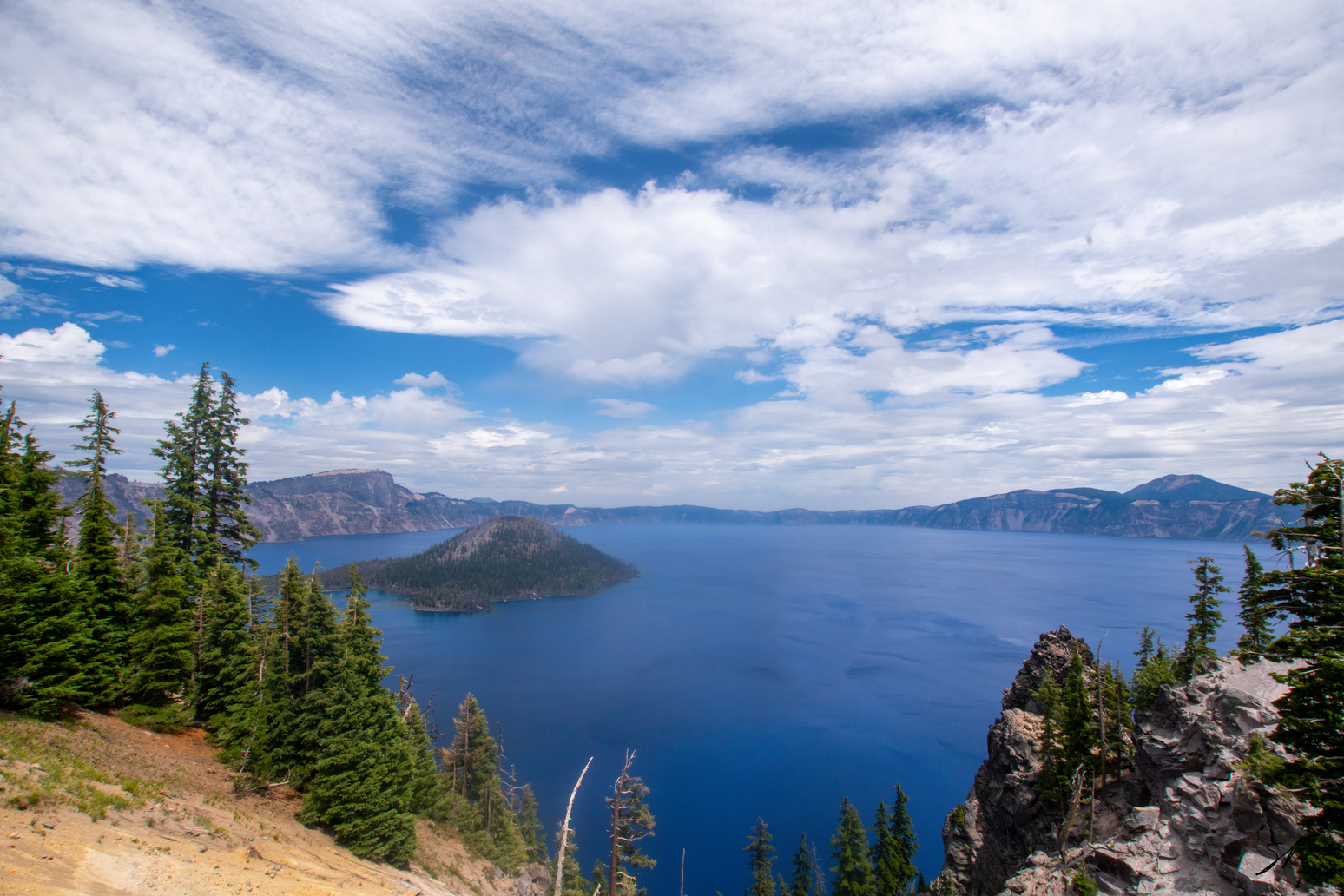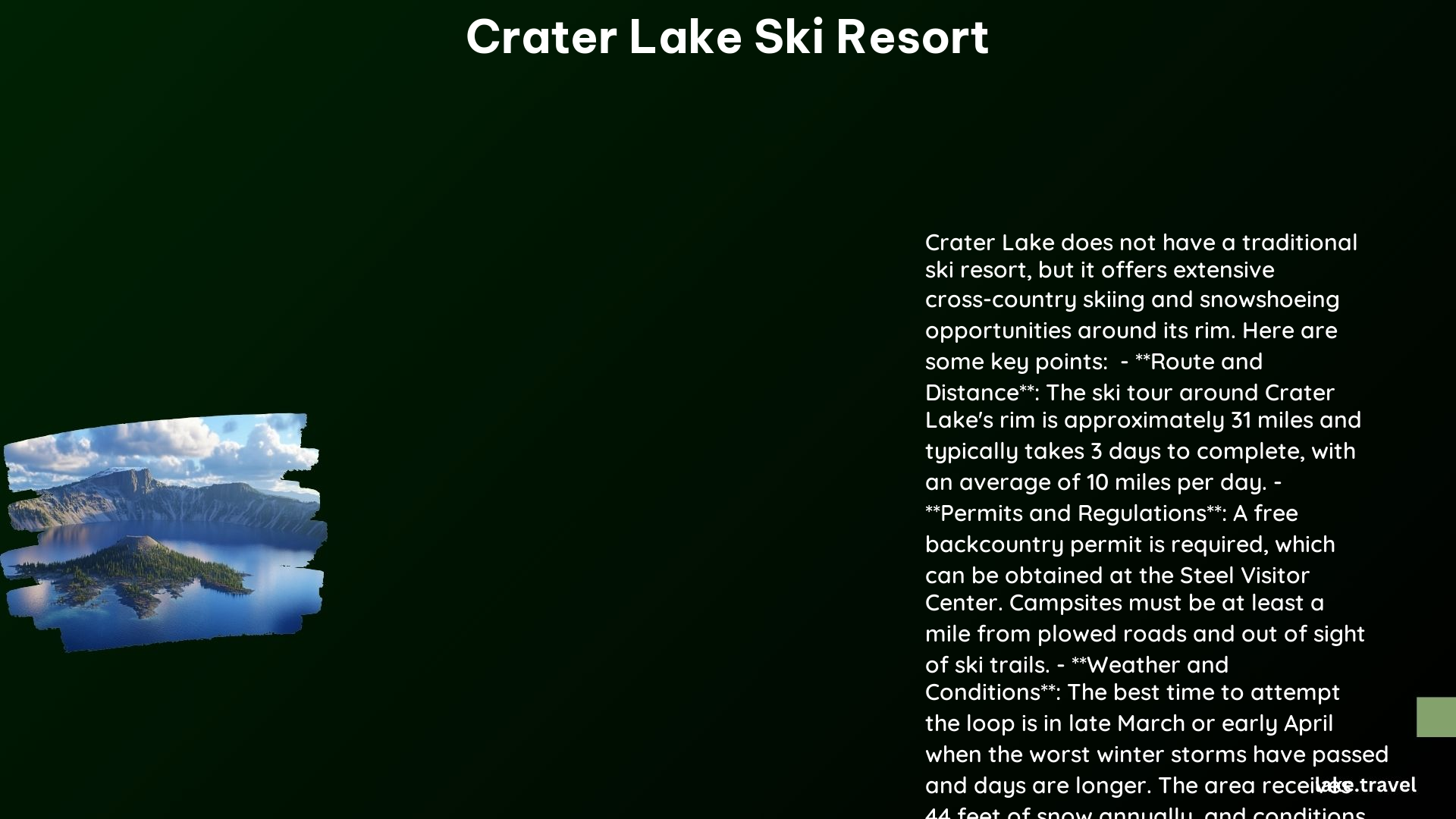Crater Lake National Park, renowned for its pristine beauty and abundant snowfall, offers a unique winter experience for ski enthusiasts. While not a traditional ski resort, the park transforms into a snowy paradise, receiving an average of 575 inches of snow annually. With snow depths ranging from 100 to 200 inches during winter, Crater Lake provides an exceptional backdrop for various winter activities, including cross-country skiing and snowshoeing. The park’s natural terrain and stunning vistas create an unforgettable skiing experience, albeit without the typical amenities of a commercial ski resort.
What Makes Crater Lake a Unique Ski Destination?

Crater Lake National Park stands out as a distinctive ski destination due to its natural beauty and pristine wilderness. Unlike conventional ski resorts, Crater Lake offers:
- Untouched natural terrain
- Breathtaking views of the deepest lake in the United States
- Opportunities for backcountry skiing and snowshoeing
- A serene, less crowded environment compared to commercial ski resorts
The park’s winter landscape provides a challenging yet rewarding experience for skiers of all levels, from beginners to advanced enthusiasts.
What Are the Snow Conditions at Crater Lake?

Crater Lake’s snow conditions are a major draw for winter sports enthusiasts. Here’s what you can expect:
- Average annual snowfall: 575 inches (48 feet)
- Typical snow depth: 100 to 200 inches (8 to 16 feet)
- Snow quality: Mix of soft and icy conditions, depending on weather patterns
The park’s high elevation and location contribute to its impressive snowfall, creating ideal conditions for various winter activities throughout the season.
Where Can Visitors Stay During Their Ski Trip?
While Crater Lake National Park doesn’t offer traditional ski resort accommodations, there are several options for visitors:
- Nearby Towns:
- Klamath Falls (60 miles away)
-
Medford (80 miles away)
-
In-Park Lodging (Seasonal):
-
Crater Lake Lodge (open mid-May to mid-October)
- Peak season rates: $200 – $400+ per night
-
Winter Camping:
- Limited backcountry camping options for experienced winter campers
It’s important to note that in-park accommodations are limited during the winter months, so planning ahead and considering nearby towns is essential for a comfortable stay.
What Ski Facilities and Services Are Available?
While Crater Lake doesn’t operate as a traditional ski resort, it offers several facilities and services for winter visitors:
| Facility/Service | Description |
|---|---|
| Trails | Various self-guided trails for skiing and snowshoeing |
| Ski Patrol | Crater Lake Ski Patrol provides information and assistance |
| Webcams | Live webcams for real-time conditions |
| Weather Reports | Up-to-date weather information for planning |
| Road Grooming | Certain closed roads are groomed for skiing and snowmobiling |
These services ensure that visitors can enjoy their winter activities safely and with access to necessary information.
How Can Visitors Access Ski Trails at Crater Lake?
Accessing ski trails at Crater Lake requires some planning:
- West Rim Drive: Closed to vehicles in winter, perfect for skiing and snowshoeing
- East Rim Drive: Also closed to traffic, offering scenic routes for winter sports
- Backcountry Access: Available for experienced skiers with proper equipment and knowledge
Visitors should check with park rangers or the Crater Lake Ski Patrol for current trail conditions and safety information before venturing out.
What Winter Activities Besides Skiing Are Available?
Crater Lake offers a variety of winter activities for non-skiers or those looking to diversify their experience:
- Snowshoeing
- Winter hiking
- Photography
- Wildlife viewing
- Ranger-led snowshoe walks (when available)
These activities allow visitors to experience the park’s winter beauty from different perspectives.
What Safety Precautions Should Skiers Take at Crater Lake?
Safety is paramount when skiing at Crater Lake. Visitors should:
- Check weather and trail conditions before heading out
- Carry appropriate safety gear (avalanche beacon, shovel, probe)
- Inform others of their plans and expected return time
- Stay on designated trails unless experienced in backcountry navigation
- Be prepared for rapidly changing weather conditions
- Carry extra food, water, and warm clothing
The park’s remote nature and challenging terrain require visitors to be well-prepared and cautious.
How Does Crater Lake Compare to Traditional Ski Resorts?
Crater Lake offers a unique skiing experience compared to traditional resorts:
Crater Lake:
– Natural, ungroomed terrain
– No lift services
– Limited facilities and amenities
– Pristine wilderness setting
– Less crowded
Traditional Ski Resorts:
– Groomed slopes
– Lift services
– Extensive facilities (lodges, restaurants, shops)
– Developed resort environment
– Often more crowded
Crater Lake appeals to those seeking a more adventurous, nature-focused skiing experience.
What Should Visitors Pack for a Crater Lake Ski Trip?
Packing appropriately is crucial for a successful Crater Lake ski trip. Essential items include:
- Cross-country skis or snowshoes
- Warm, layered clothing
- Waterproof outerwear
- Sunglasses and sunscreen
- Navigation tools (map, compass, GPS)
- First aid kit
- Emergency shelter
- High-energy snacks and water
- Camera for capturing the stunning scenery
Proper equipment ensures a safe and enjoyable experience in the park’s challenging winter environment.
When Is the Best Time to Visit Crater Lake for Skiing?
The best time to visit Crater Lake for skiing typically falls between December and April, with peak conditions often occurring in February and March. Factors to consider include:
- Snow depth and quality
- Daylight hours
- Temperature ranges
- Park accessibility
Visitors should check the park’s official website for current conditions and road closures before planning their trip.
How Can Visitors Prepare for Backcountry Skiing at Crater Lake?
Backcountry skiing at Crater Lake requires thorough preparation:
- Develop advanced skiing skills and fitness
- Take avalanche safety courses
- Learn winter navigation techniques
- Invest in high-quality backcountry gear
- Study the park’s terrain and potential hazards
- Check weather forecasts and avalanche reports
- Register with park rangers before heading out
Proper preparation ensures a safer and more enjoyable backcountry experience in this challenging environment.
In conclusion, while Crater Lake National Park may not offer the amenities of a traditional ski resort, it provides a unique and breathtaking winter sports experience. Its natural beauty, abundant snowfall, and diverse terrain make it an ideal destination for adventurous skiers and winter enthusiasts seeking a more pristine and challenging environment. By understanding the park’s unique characteristics and preparing accordingly, visitors can enjoy a truly memorable skiing experience in one of America’s most stunning natural settings.
References:
1. Crater Lake Institute – Weather and Climate
2. National Park Service – Crater Lake National Park
3. Crater Lake Ski Patrol
